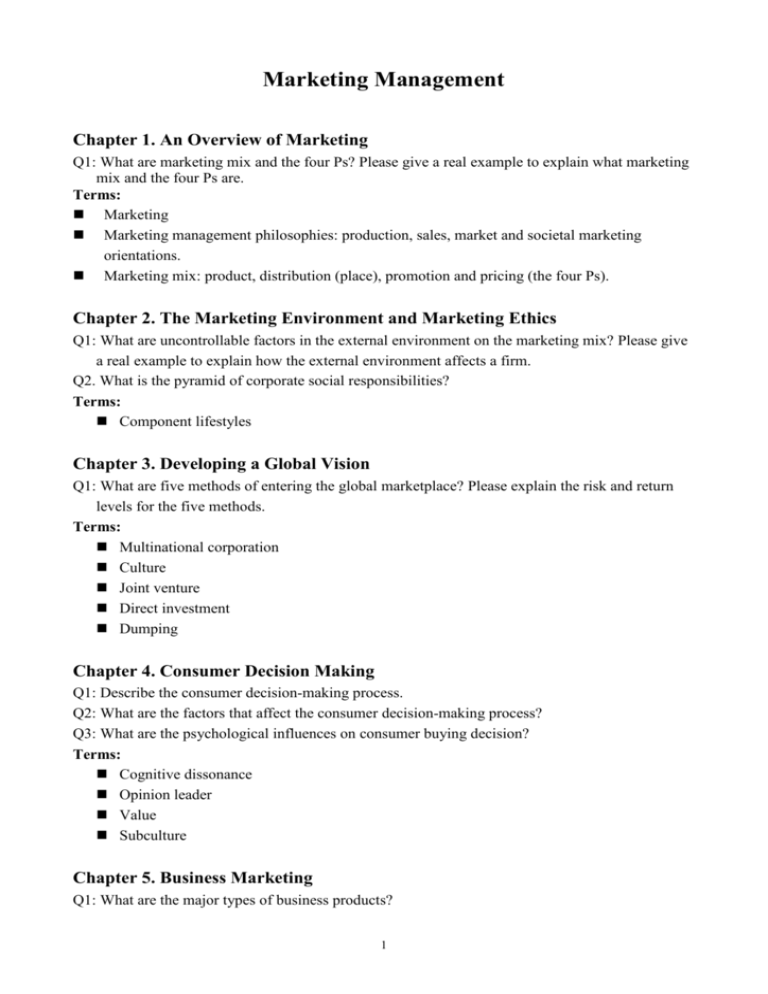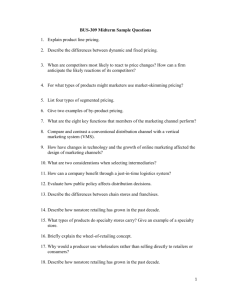Questions for final exam
advertisement

Marketing Management Chapter 1. An Overview of Marketing Q1: What are marketing mix and the four Ps? Please give a real example to explain what marketing mix and the four Ps are. Terms: Marketing Marketing management philosophies: production, sales, market and societal marketing orientations. Marketing mix: product, distribution (place), promotion and pricing (the four Ps). Chapter 2. The Marketing Environment and Marketing Ethics Q1: What are uncontrollable factors in the external environment on the marketing mix? Please give a real example to explain how the external environment affects a firm. Q2. What is the pyramid of corporate social responsibilities? Terms: Component lifestyles Chapter 3. Developing a Global Vision Q1: What are five methods of entering the global marketplace? Please explain the risk and return levels for the five methods. Terms: Multinational corporation Culture Joint venture Direct investment Dumping Chapter 4. Consumer Decision Making Q1: Describe the consumer decision-making process. Q2: What are the factors that affect the consumer decision-making process? Q3: What are the psychological influences on consumer buying decision? Terms: Cognitive dissonance Opinion leader Value Subculture Chapter 5. Business Marketing Q1: What are the major types of business products? 1 Q2. Describe the three important criteria for evaluating products and suppliers to business buyers. Terms: Electronic commerce Strategic alliance Derived demand Chapter 6. Segmenting and Targeting Markets Q1: What is the market segmentation? Please give a real example to explain how a firm or a product segments market. Q2: Describe some bases for segmenting consumer markets. Q3: What are the common bases of demographic and psychographic segmentation? Q4: Describe the steps in segmenting a market. Terms: Market segmentation Family life cycle Usage-rate segmentation Cannibalization Positioning Product differential Chapter 7. Decision Support Systems and Marketing Research Q1: What are the steps in a marketing research process? Q2. Describe some forms of survey research. Terms: Primary data Secondary data Open-ended question Closed-ended question Scaled-response question Scanner-based research Chapter 8. Product and Services Concepts Q1: What are the product packing functions? Terms: Business product Product line Cobranding Labeling Chapter 9. Developing and Managing Products Q1: What is the new-product development process? 2 Q2. Describe the product life cycle. Terms: Brainstorming Commercialization Chapter 10. Marketing Channels and Supply Chain Management Q1: What are the marketing channel functions performed by intermediaries? Terms: Marketing channels Retailer Merchant wholesalers Agent and broker Mass customization (Build-to-order, BTO) Just-in-time production (JIT) Chapter 11. Retailing Q1: What are the major types of retail operations? Q2: What are the major forms of nonstore retailing? Q3: What are the six Ps of retailing mix? Q3: What are the most influential factors in creating store’ s atmosphere? Terms: Chain stores Direct retailing Catalogs and mail order Chapter 12. Integrated Marketing Communications Q1: What is the AIDA concept which is a classic model for reaching promotional goals? Q2: What are the factors affecting the promotional mix? Terms: Promotional mix Push strategy Pull strategy Integrated marketing communications (IMC) Chapter 13. Advertising and Public Relations Q1: What are the common advertising appeals? Q2: What are the common executional styles for advertising? Q3. Describe some media types for advertising. Terms: Advocacy advertising 3 Chapter 14. Sales Promotion and Personal Selling Q1: Describe some tools for consumer sales promotion? Q2: Describe some tools for trade sales promotion? Q3. What are the seven basic steps in the personal selling process? Terms: Coupons Point-of-purchase promotion Sales force Cold calling Chapter 15. Internet Marketing Q1: Give some cases or webs of internet marketing. What marketing activities are there on the internet? Terms: E-commerce Chapter 16. Pricing Concepts Q1: What are the factors that affect elasticity of demand? Q2: Describe the four-step process of setting the right price on a product? Q3. Describe some tactics for fine-tuning the base price? Terms: Status quo pricing Markup pricing Break-even pricing Prestige pricing Price skimming Penetration pricing Leader pricing Bait pricing Odd-even pricing Bundle pricing Two-part pricing 4





